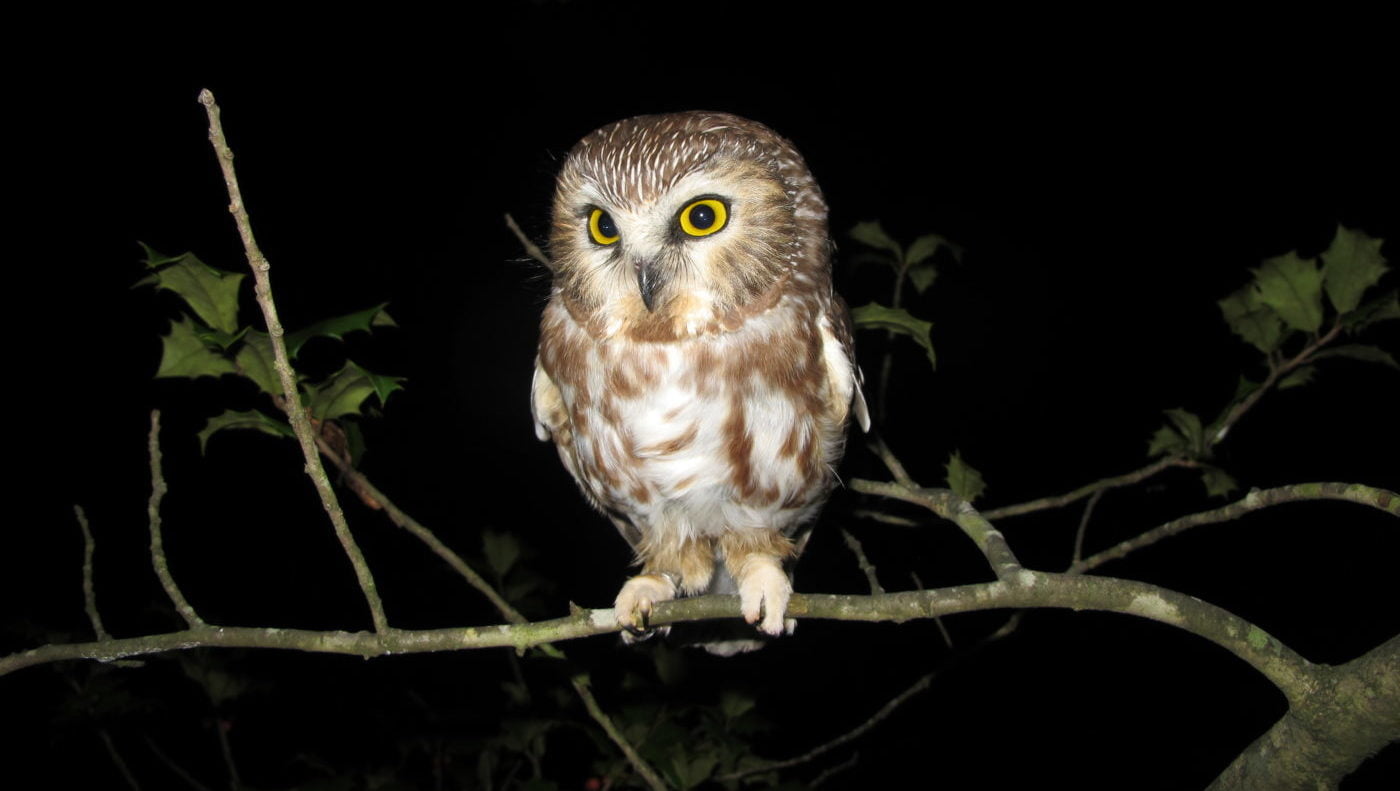When it comes to Virginia’s owls, the Eastern Screech-Owl is often thought of as our smallest species. But that distinction really belongs to the Northern Saw-whet Owl. It can be distinguished from the Screech-Owl by its rounded facial disk, distinctive facial V pattern, lack of ‘ear’ tufts, and the adult’s broad, vertical streaking (as opposed to the Screech-Owl’s horizontal barring) on the breast and belly. The male’s song is a persistent, high-pitched ‘toot’.

Northern Saw-whet Owl. Photo by J.D. Kleopfer
Although traditionally believed to be associated exclusively with coniferous habitat, Saw-whets are now thought to have a much broader habitat preference. They breed in mixed hardwood/coniferous forests, and to a lesser extent in pure hardwood forests in some of Virginia’s neighboring states.
Relatively little is known about Saw-whets in Virginia due to their nocturnal and secretive habits. We do know that Saw-whets migrate through the Commonwealth in the fall, and that this population of migrants can vary significantly from year to year, with ‘irruption’ or ‘invasion’ years seeing particularly high numbers. We also know that Saw-whets winter in Virginia, with numbers again potentially fluctuating between years.
Winter and migration data are the result of banding efforts at various locations in the Coastal Plain, Piedmont and Mountains regions of Virginia over the past 15-20 years. However, data on the Saw-whet’s breeding distribution and status in the Commonwealth are scarce.
Filling this data gap through the 2nd VA Breeding Bird Atlas (VABBA2), especially in this, its Year of the Night Birds, is a high priority for the bird conservation community at large. (The VABBA2 is a project of DGIF, the Virginia Society of Ornithology and the Conservation Management Institute at Virginia Tech that aims to catalogue the current distribution and status of Virginia’s breeding birds.)
Little in the way of formal breeding surveys have been conducted for Saw-whets in Virginia. The first confirmed nesting record in Virginia was obtained during the first Breeding Bird Atlas when a check of a Northern Flying Squirrel nest box by DGIF biologists on Clinch Mountain Wildlife Management Area in late March 1989 revealed two Saw-whet eggs.
The Virginia Society of Ornithology focused its annual Foray in 2006 specifically on Saw-whet surveys in mid-April to early June. A total of 16 owls were detected in various counties west of the Blue Ridge. The majority of spring and summer Saw-whet reports are from the western part of the state, ranging from Frederick County to southwest Virginia.
This year, the Blue Ridge Discovery Center is beginning research on local breeding of Saw-whets on Mount Rogers and Whitetop Mountain. Their project is a great start, but more information is needed over a broader geographic scale.
You can help gather that needed information by conducting Saw-whet surveys for the VABBA2. If you are interested in participating, visit the VABBA2 eBird portal for more information and detailed instructions.
By taking part in this survey effort, you will be contributing to the broader VABBA2 and bird research in the Commonwealth, all of which is an excellent way to join in the Year of the Bird celebration.
This article is brought to you by Virginia Department of Game & Inland Fisheries (DGIF), in support of the Year of the Bird, a celebration of birds that marks the centennial of the Migratory Bird Treaty Act (MBTA), one of the first laws passed to protect wildlife and one of the most important for birds. DGIF asks you to join your fellow wildlife-enthusiasts in this celebration by taking simple, meaningful actions to protect birds in 2018 and beyond.


